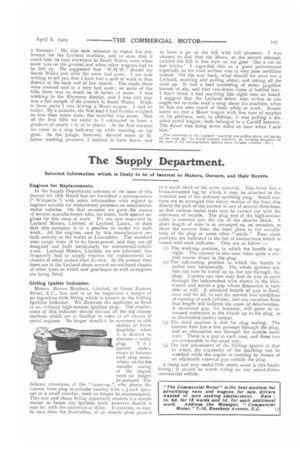The Supply Department.
Page 17

If you've noticed an error in this article please click here to report it so we can fix it.
Selected Information which is likely to be of Interest to Makers, Owners, and their Buyers.
Engines for Replacements.
In the Supply Department columns of the issue of this journal for t8th March last we furnished a correspondent (" Wimperis ") with some information with regard to engines suitable for replacement purposes on commercialmotor vehicles. On that occasion we gave the names of several manufacturers who, we knew, built special engines for this class of work. We are now requested by Leyland Motors, Limited, of Leyland, Lancs., to state that this company is in a position to tender for such work. All the engines used by this manufacturer are built entirely at the works in Lancashire. The standard sizes range from 18 to Go horse-power, and they are all designed and built particularly for commercial-vehicle work. Leyland Motors, Limited, we are informed, has frequently had to supply engines for replacements on chassis of other makes than its own. At the present time there are in the Leyland shops several second-hand chassis of other types to which new gearboxes as well as engines are being fitted.
Girling Igniter Indicator.
Messrs. Brown Brothers, Limited, of Great Eastern Street, E.C., has sent to us for inspection a sample of an ingenious little fitting which is known as the Girling Ignition Indicator. We illustrate the appliance as fitted to an ordinary high-tension ignition plug. The employment of this indicator should obviate all the old clumsy methods which are so familiar to users of all classes of petrol engines. No longer should it be necessary to risk shocks or burnt knuckles when it is desired to discover a faulty
plug. h e patient endeavours to balance each plug somewhere on the hat metallic casing of the engine need no longer be pursued. The attentions of the " tuner-up," who shorts the current from plug to cylinder casting with a i-inch spanner or a small crowbar, need no longer be countenanced. This new and cheap fitting apparently renders it a simple matter to locate any ignition fault, however elusive it may be, with the minimum of delay. It consists, as may be seen from the illustration, of an ebonite plate pivoted delicate
to a small block of the same material. This latter has a brass-mounted lug by which it may be attached to the terminal end of the ordinary sparking plug. Small contacts are so arranged that rotary motion of the front disc directs the path of the current in any of several directions, so that various useful tests may be carried out with the minimum of trouble. The plug end of the high-tension cable is inserted into the top of the ebonite block. A short length of wire is so arranged as, on occasion, to short the current from the front plate to the metallic body of the plug or some other "earth." Four main positions are indicated in the list of instructions which is issued with each indicator. They are as follow :—
(t) The worldng position, in which the handle is upright. The current in this case takes quite a normal course direct to the plug.
(2) The coil-testing position in which the handle is pulled over horizontally. The whole ignition system can now be tested up to, but not through, the plug. Current can now only find its way to earth through the independent wire shown in the illustration and across a gap whose dimension is variable at will. A standard length of gap is fixed, once and for all, to suit the normal best conditions of running of each cylinder, and any variation from that length will indicate the cause of deterioration. A shortened gap, for instance, will point to increased resistance in the circuit up to the plug, or to diminished battery output.
The third position is that for plug testing. The current here has a free passage through the plug, and an alternative one through the outside earth wire. There is a gap in each case, and these two are comparable in the usual way.
The last adjustment of the Girling igniter is that in which the regularity of the sparking can be watched while the engine is running by means of an adjustable external gap outside the plug.
A cheap and very useful little worry saver is this handy fitting; it should be worth trying on any petrol-driven commercial vehicle.


















